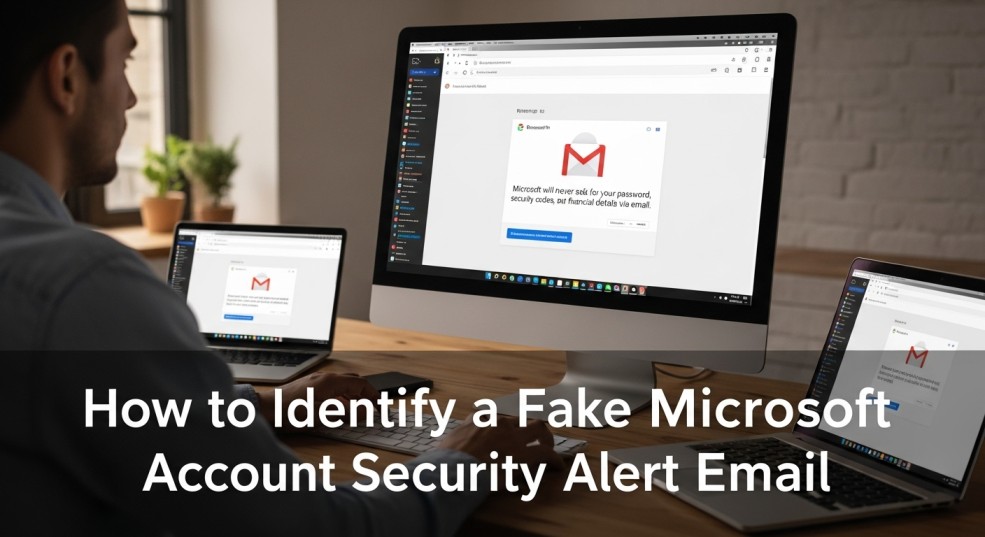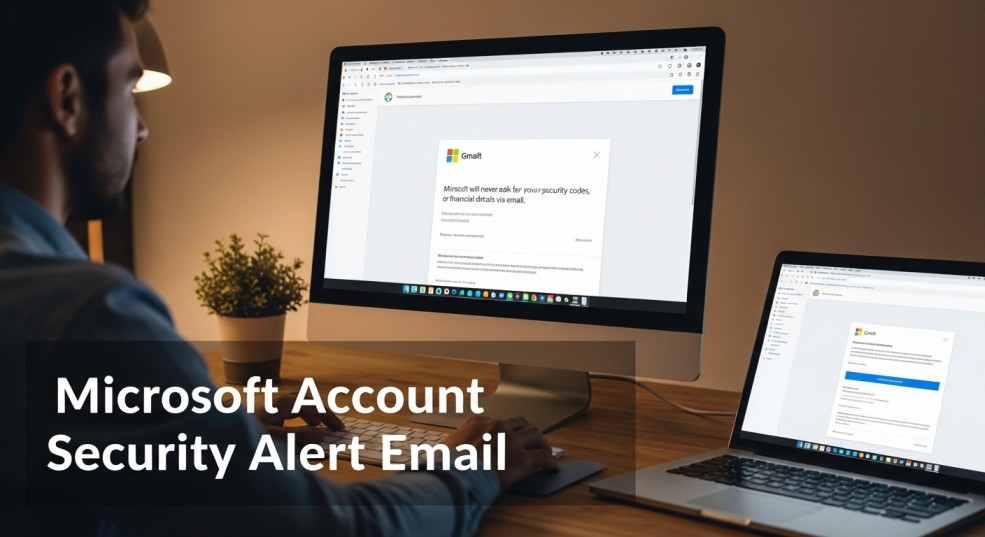Alerts Understanding Microsoft Account Security
Microsoft Account Security Alert emails are designed to inform you about unusual activity on your account. However, cybercriminals use sophisticated phishing scams to mimic these alerts, aiming to steal your personal information, passwords, and financial data. This guide provides crucial information to help you differentiate between genuine alerts and fraudulent ones, offering step-by-step instructions to secure your account. Staying calm and vigilant is your first line of defense.
Always remember that Microsoft will never ask for sensitive information like your password or financial details via email. If an email urges immediate action or requests such information, it's highly likely a scam. It's essential to be proactive in protecting your online security.
Spotting Scams How to Identify a Fake Microsoft Account Security Alert Email
Cybercriminals are constantly evolving their tactics. Here's how to identify a fake Microsoft Account Security Alert email:
1. Check the Sender’s Email Address: Legitimate emails from Microsoft will come from official domains such as: @accountprotection.microsoft.com, @microsoft.com, or @email.microsoft.com. Scam emails often use addresses that mimic these but contain subtle misspellings or unrelated domains. Always scrutinize the sender's email address carefully.
2. Look for Red Flags in the Content: Pay close attention to the language used. Urgent or threatening phrases like 'Immediate action required' or 'Your account will be suspended' are designed to induce panic. Generic greetings like 'Dear User' or 'Dear Customer' are common in scams. Poor grammar and spelling are also strong indicators of a phishing attempt. Suspicious links or attachments are a major red flag. Hover over links (without clicking) to reveal the actual URL; legitimate links will direct you to Microsoft domains (e.g., account.microsoft.com).
3. Verify the Email’s Purpose: Legitimate emails will inform you of specific activities, such as unusual sign-in attempts or password changes, and guide you to review your account activity officially. Scam emails often request personal information, passwords, or payment details, which Microsoft will never do. This is a crucial distinction.
Take Action Immediate Actions to Take If You Receive a Suspicious Microsoft Account Security Alert Email
If you suspect an email is a scam, take these immediate actions:
1. Do Not Click Any Links or Attachments: Clicking links could lead to malicious websites designed to steal your information. Instead, open a new browser tab and manually type in Microsoft’s official website (account.microsoft.com).
2. Check Your Account Activity Directly: Log into your Microsoft account directly and navigate to the Recent Activity section. This will show you any legitimate security alerts or unusual sign-in attempts.
3. Change Your Password and Enable 2FA: If you suspect unauthorized access, change your password immediately. Use a strong, unique password combining letters, numbers, and symbols. Enable Two-Factor Authentication (2FA) for an added layer of security. This requires a second form of verification (e.g., a text message or authentication app) to access your account.
4. Report the Phishing Attempt: Forward the suspicious email to phishing@microsoft.com (as an attachment, if possible). Use the 'Report phishing' option in your email client (e.g., Outlook or Outlook.com) to alert Microsoft.
5. Monitor Your Accounts: Regularly review your financial and Microsoft accounts for unauthorized activity. If you notice anything suspicious, contact your bank or Microsoft Support immediately.
Strengthen How to Your Account Security
Enhance your account security with these best practices:
1. Enable Two-Factor Authentication (2FA): 2FA significantly reduces the risk of unauthorized access, even if your password is compromised.
2. Use Strong, Unique Passwords: Avoid reusing passwords across multiple sites. Consider using a password manager to generate and store complex passwords.
3. Keep Software Updated: Regularly update your operating system and security software to protect against vulnerabilities.
4. Educate Yourself and Others: Learn to recognize phishing tactics and share this knowledge with friends, family, or colleagues.
“Always scrutinize the sender's email address and content for any signs of a phishing attempt.
Cybersecurity Expert
Interactive Features
Enhance your security knowledge!
Phishing Quiz
Test your ability to identify phishing emails with our interactive quiz!
Account Security Checklist
Get a personalized checklist to improve your Microsoft account security.
Comparison Key Differences Between Legitimate and Scam Emails
Understanding the differences can help you quickly identify a potential scam:
Feature: Sender’s Address Legitimate: @accountprotection.microsoft.com, @microsoft.com, or @email.microsoft.com Scam: Slight misspellings or unrelated domains
Feature: Greeting Legitimate: Personalized with your full name Scam: Generic (e.g., “Dear User” or “Dear Customer”)
Feature: Language Legitimate: Professional and clear Scam: Urgent or threatening tone
Feature: Links Legitimate: Direct to official Microsoft domains (e.g., account.microsoft.com) Scam: Direct to suspicious or unrelated sites
Feature: Attachments Legitimate: Rarely included Scam: Often include malicious attachments
Feature: Requests for Information Legitimate: Never asks for passwords or financial details Scam: Asks for sensitive information
FAQs Frequently Asked Questions: Microsoft Account Security Alert Email
Does Microsoft send security alerts via email? Yes, but they will never ask for passwords or financial details. Always verify by logging into your account directly.
What should I do if I click a link in a suspicious email? Change your password immediately, run a virus scan, and monitor your accounts for unusual activity.
How can I report a phishing email? Forward it to phishing@microsoft.com or use the “Report phishing” option in your email client.
Can I prevent these emails from reaching my inbox? Use email filters and enable built-in spam detection in your email client to reduce phishing attempts.
How do I know if a Microsoft security alert email is real? A real alert will never ask for your password and comes from the official sender.
Is Gmail linked to a Microsoft account? A Gmail address can be used as the username for a Microsoft account, but they are separate services; one is not inherently linked to the other.
What is the official Microsoft account security email? The official sender for security alerts is @accountprotection.microsoft.com, @microsoft.com, or @email.microsoft.com.
How do I know if a security alert from Google is real? Never click links in the email. Instead, go directly to your Google account’s security page to check for any real alerts.
Is there a fake Microsoft security alert? Yes, fake Microsoft security alerts are a very common phishing scam designed to steal your login credentials.
How do I check who is trying to access my Microsoft account? Go to your Microsoft account’s “Recent activity” page to see all sign-in attempts, locations, and devices.
Why is Microsoft sending me an email about my Gmail account? Microsoft would not email you about a Gmail account; this is a sure sign of a phishing scam.
What email address does Microsoft use? For security alerts, Microsoft uses @accountprotection.microsoft.com, @microsoft.com, or @email.microsoft.com.
How to access Microsoft account with Gmail? If your Gmail is your Microsoft account username, just use it to sign in on Microsoft’s official login page.
Why did I receive a Microsoft verification code but didn’t request it? It likely means someone else has your password and is trying to log in, but they can’t without the code. Change your password immediately.
What is the name of the Microsoft email security? Microsoft’s enterprise email security service is called Microsoft Defender for Office 365.
What can someone do with your Microsoft account? They can access your email, personal files, and payment info, and use your account to scam your contacts.
Stay Safe Conclusion: Microsoft Account Security Alert Email - Stay Vigilant and Secure
Microsoft Account Security Alert Emails are a vital tool for protecting your account, but scammers exploit them to deceive users. By following the steps outlined in this guide, you can confidently identify scams, take immediate action to secure your account, and prevent future threats.
Remember: Never share passwords or financial details via email. Verify alerts by logging into your account directly. Enable Two-Factor Authentication for enhanced security. Report suspicious emails to help protect others. Stay informed and proactive to safeguard your digital life. If in doubt, contact Microsoft Support through their official website for assistance.